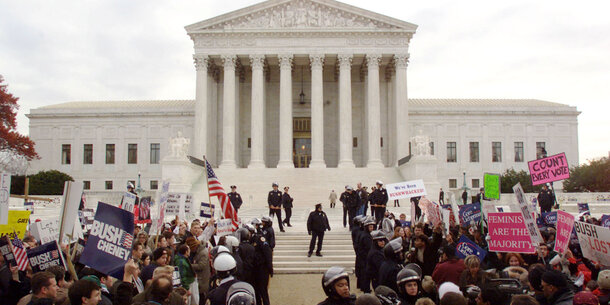The Midterm Monitor is a joint project of the Brennan Center and the Alliance for Securing Democracy at the German Marshall Fund. Launched in September 2022, it gathers data from accounts affiliated with candidates for governor, secretary of state, the House, and the Senate. In addition, it captures data from the accounts of influential national media outlets and pundits, the most followed local media outlets in 10 battleground states, non-English-language media outlets in the United States, and state media and diplomats associated with the Chinese, Iranian, and Russian governments.
We are using the Midterm Monitor to conduct and publish analyses to help understand the online messaging about the 2022 midterm elections. Here are some of our key findings so far:
- The most shared links and retweeted media entities by monitored Republican and Democratic candidates show just how much candidates are operating in separate information bubbles. The notable exceptions were Republican candidates who are not election deniers, who shared information from sources that overlapped as much with Democrats as election denier Republicans.
- A large percentage of posts from candidates for secretary of state perpetuate false election narratives. More than 31 percent of their Facebook posts and nearly 19 percent of their Instagram and Twitter posts promote false narratives about the election.
- Despite election fraud being exceptionally rare, analysis of all the posts by U.S. candidates between September 3, 2022, and October 3, 2022, shows that it is a major topic of discussion among candidates. Between January 2 and October 20, election fraud–related candidate tweets were also more likely to be retweeted than candidate tweets about the election in general.
Findings from Posts of All Candidates on the Midterm Monitor
Republican and Democratic candidates share information from largely separate information bubbles on Twitter
The most shared links and retweeted media entities by monitored Republican and Democratic candidates reveal the extent to which political candidates operate in separate information bubbles. Between July 1 and October 13, we analyzed the 20 most retweeted Twitter accounts affiliated with local or national media outlets, journalists, or pundits and the 20 most linked-to domains that were most frequently shared by monitored candidates. For analysis of links, we also segmented Republican candidates by those identified as election deniers and those who are not. For analysis of retweets and links, we removed retweets and shares of inherently political accounts (e.g., other candidates, party accounts, activists, etc.) and links to inherently political domains (e.g., campaign websites, fundraising platforms, etc.) — where one would expect to find stark differences between the two parties.
Our analysis of retweets from monitored Republican and Democratic candidates uncovered the following findings:
- There was only one Twitter account affiliated with a national media outlet or pundit — the Hill — that ranked among the 20 most retweeted media accounts by both monitored Republicans and Democrats.
- The most retweeted media account by monitored Republican candidates was Jack Posobiec, the former OANN reporter who was central to the “Pizzagate” conspiracy theory and 2020 election denialism. However, roughly 40 percent of his retweets came from one candidate — Pennsylvania gubernatorial candidate Doug Mastriano. (While Posobiec could be classified as an activist, his former role as an OANN reporter and frequent media appearances earned him a media designation).
- None of the top 20 media accounts retweeted by Democrats were affiliated with conservative or center-right outlets or individuals, just as none of the top 20 media accounts retweeted by Republicans were affiliated with left-leaning outlets, as defined by AllSides media bias ratings.
- While three of the five most retweeted accounts by monitored Republicans were affiliated with traditional or legacy media outlets (Fox News, a Fox News reporter, and the New York Post), the vast majority of the most retweeted media accounts from monitored GOP candidates were Twitter accounts associated with individuals or entities affiliated with newer and largely digital outlets, most of which AllSides rates as being on the far right of the political spectrum.
- Roughly half of the most retweeted media accounts by Democrats were affiliated with traditional or legacy media outlets, including four accounts affiliated with MSNBC.
- There were no local media accounts among the 20 most retweeted media accounts by candidates of either party, though this is not entirely surprising given the national scope of the analysis. (We classify the Washington Post and New York Times as national outlets.)
Republican candidates who are not election deniers are a partial exception to the rule about partisan information bubbles
We segmented Republican candidates by those identified as election deniers by States United Action and FiveThirtyEight and those who have either accepted the results of the 2020 election or haven’t publicly stated an opinion on the validity of the results.
Analysis of the domains most linked to in tweets by monitored Democratic and Republican candidates and by election denier and non–election denier Republicans during the studied period revealed the following findings:
- There was significant overlap between the top 10 most shared domains from election denier and non–election denier Republicans. Beyond the top 10, however, there was a clear divergence, with election deniers favoring far-right sites and non–election deniers linking to more centrist and, in some cases, even left-leaning outlets.1
- In total, there were only 9 domains in common between the 20 domains most shared by election denier and non–election denier Republicans.
- Of the top 20 domains shared by monitored non–election denier Republican candidates and monitored Democrats, there were also 9 domains in common — the same number of domains in common in the lists of the top 20 news sources shared by election denier and non–election denier Republicans.
Posts about fraud are getting outsized attention on social media
Fraud in elections is exceptionally rare, but it is getting a lot of attention on social media. Topic modeling2of election-related tweets by all candidates between September 3 and October 3 showed that “fraud” was one of the most frequently discussed topics on Twitter across different races. In addition, between January 2 and October 20, candidates’ tweets related to election fraud were more likely to be retweeted than their other election-related tweets.
These tweets have gained traction despite the fact that the majority of voters nationwide are broadly confident in the results of the 2020 presidential election, according to a poll recently released by R Street and the Brennan Center. And, when presented with information about existing election safeguards, voter confidence increased across the board, including among Republicans.
The Brennan Center recently published an analysis of myths we are seeing perpetuated on the Midterm Monitor, alongside facts about the election process that correct the record.
Findings About Posts Coming from Secretary of State Candidates
False narratives about elections are a central and growing topic of election-related social media posts by candidates for secretary of state
A large percentage of posts related to elections from candidates for secretary of state perpetuate false election narratives,3and at least on Twitter, the percentage of such posts is growing as we get closer to Election Day. (We have not yet studied whether there is a similar pattern on other social media platforms, though Twitter has by far the highest number of posts by candidates for secretary of state of any of the platforms we have reviewed.) The vast majority of these posts came from candidates who have already been publicly identified as election deniers.4
- Of 201 election-related posts shared by secretary of state candidates on Facebook between September 1 and September 27, 63 — more than 31 percent — perpetuate a false narrative, including claims that large-scale so-called “ballot harvesting” took place in 2020 or that Joe Biden’s win was statistically impossible.
- Of 66 election-related posts shared by secretary of state candidates on Instagram between September 1 and September 27, 12 — nearly 19 percent — perpetuate a false narrative.
- Of 387 election-related tweets from secretary of state candidates between September 1 and September 27, 72 — more than 18 percent — perpetuate a false narrative.
Taken together, the activity across different social media platforms paints a clear picture of the prevalence of election denialism by secretary of state candidates on social media. Analysis of Twitter further demonstrates that secretary of state candidates are increasingly promoting false narratives online as the election nears, with the percentage of false election narratives compared to all election-related tweets by candidates rising from 7 percent between August 13 and August 26 to 12 percent between August 27 and September 9 to 22 percent between September 10 and September 23.
Endnotes
-
1
AllSides media bias ratings were used to determine the political leanings of analyzed domains. -
2
Topic modeling is a machine learning approach. It uses statistics and natural language processing to identify and cluster topics within text. -
3
A team of Brennan Center analysts hand coded posts by secretary of state candidates on Twitter, Facebook, and Instagram for the month of September. The analysts coded for 37 different false narratives related to election administration. The list was created by Brennan Center researchers. The false narratives are based on key narratives perpetuated ahead of and after the 2020 election. -
4
Election denial — claims that the process or result of the last presidential election was illegitimate — has become a highly visible issue in contests around the country, particularly for election administration positions such as secretaries of state. Candidates for these offices are making their claims about the legitimacy of the last election central to their case that voters should choose them to run the next one. Approximately 97 percent of the posts on Twitter and Facebook and 92 percent of the Instagram posts that were coded as perpetuating a false narrative were posted by candidates identified as election deniers in a recent States United study.



